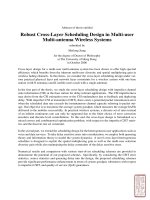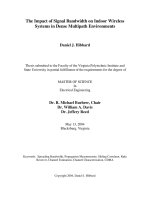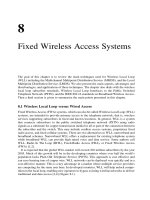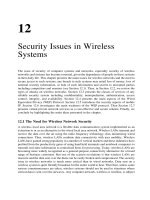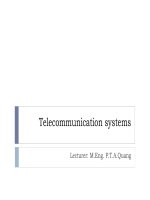Ch4 wireless telecommunication systems
Bạn đang xem bản rút gọn của tài liệu. Xem và tải ngay bản đầy đủ của tài liệu tại đây (1.53 MB, 52 trang )
Mobile Communications
Chapter 4: Wireless
Telecommunication Systems
GSM
Overview
Services
Sub-systems
Components
IS 95
Overview
Services
Sub-systems
Components
Mobile phone subscribers worldwide
700000
subscribers (x 1000)
600000
Analog total
500000
GSM total
400000
CDMA total
300000
TDMA total
PDC/PHS total
200000
total
100000
0
1996
1997
1998
ICS 243E - Ch4. Wire
1999
2000
2001
Winter 2001
4.2
GSM: Overview
GSM
formerly: Groupe Spéciale Mobile (founded 1982)
now: Global System for Mobile Communication
Pan-European standard (ETSI, European Telecommunications
Standardisation Institute)
simultaneous introduction of essential digital cellular
services in three phases (1991, 1994, 1996) by the European
telecommunication administrations, seamless roaming within
Europe possible
today many providers all over the world use GSM (more than
130 countries in Asia, Africa, Europe, Australia, America)
more than 100 million subscribers
ICS 243E - Ch4. Wire
Winter 2001
4.3
Performance characteristics of GSM
Communication
mobile, wireless digital communication; support for voice and
data services
Total mobility
international access, chip-card enables use of access points
of different providers
Worldwide connectivity
one number, the network handles localization
High capacity
better frequency efficiency, smaller cells, more customers per
cell
High transmission quality
high audio quality
uninterrupted phone calls at higher speeds (e.g., from cars,
trains) – better handoffs and
Security functions
access control, authentication via chip-card and PIN
ICS 243E - Ch4. Wire
Winter 2001
4.4
Disadvantages of GSM
There is no perfect system!!
no end-to-end encryption of user data
no full ISDN bandwidth of 64 kbit/s to the user, no transparent
B-channel
abuse of private data possible
roaming profiles accessible
high complexity of the system
several incompatibilities within the GSM standards
ICS 243E - Ch4. Wire
Winter 2001
4.5
GSM: Mobile Services
GSM offers
several types of connections
voice connections, data connections, short message service
multi-service options (combination of basic services)
Three service domains
Bearer Services – interface to the physical medium (transparent for
example in the case of voice or non transparent for data services)
Telematic Services – services provided by the system to the end user
(e.g., voice, SMS, fax, etc.)
Supplementary Services – associated with the tele services: call
forwarding, redirection, etc.
bearer services
MS
TE
MT
R, S
GSM-PLMN
Um
transit
network
(PSTN, ISDN)
source/
destination
network
TE
(U, S, R)
tele services
ICS 243E - Ch4. Wire
Winter 2001
4.6
Bearer Services
Telecommunication services to transfer data between access
points
R and S interfaces – interfaces that provide network independent data
transmission from end device to mobile termination point.
U interface – provides the interface to the network (TDMS, FDMA, etc.)
Specification of services up to the terminal interface (OSI layers 13)
Transparent – no error control of flow control, only FEC
Non transparent – error control, flow control
Different data rates for voice and data (original standard)
voice service (circuit switched)
synchronous: 2.4, 4.8 or 9.6 Kbps.
data service (circuit switched)
synchronous: 2.4, 4.8 or 9.6 kbit/s
asynchronous: 300 - 1200 bit/s
data service (packet switched)
synchronous: 2.4, 4.8 or 9.6 kbit/s
asynchronous: 300 - 9600 bit/s
ICS 243E - Ch4. Wire
Winter 2001
4.7
Tele Services I
Telecommunication services that enable voice communication via
mobile phones
All these basic services have to obey cellular functions, security
measures etc.
Offered voice related services
mobile telephony
primary goal of GSM was to enable mobile telephony offering
the traditional bandwidth of 3.1 kHz
Emergency number
common number throughout Europe (112); mandatory for all
service providers; free of charge; connection with the highest
priority (preemption of other connections possible)
Multinumbering
several ISDN phone numbers per user possible
ICS 243E - Ch4. Wire
Winter 2001
4.8
Tele Services II
Additional services: Non-Voice-Teleservices
group 3 fax
voice mailbox (implemented in the fixed network supporting the
mobile terminals)
electronic mail (MHS, Message Handling System, implemented in
the fixed network)
...
Short Message Service (SMS)
alphanumeric data transmission to/from the mobile terminal
using the signaling channel, thus allowing simultaneous use of
basic services and SMS (160 characters)
ICS 243E - Ch4. Wire
Winter 2001
4.9
Supplementary services
Services in addition to the basic services, cannot be offered
stand-alone
May differ between different service providers, countries and
protocol versions
Important services
identification: forwarding of caller number
suppression of number forwarding
automatic call-back
conferencing with up to 7 participants
locking of the mobile terminal (incoming or outgoing calls)
...
ICS 243E - Ch4. Wire
Winter 2001
4.10
Architecture of the GSM system
GSM is a PLMN (Public Land Mobile Network)
several providers setup mobile networks following the GSM
standard within each country
components
MS (mobile station)
BS (base station)
MSC (mobile switching center)
LR (location register)
subsystems
RSS (radio subsystem): covers all radio aspects
NSS (network and switching subsystem): call forwarding, handover,
switching
OSS (operation subsystem): management of the network
ICS 243E - Ch4. Wire
Winter 2001
4.11
GSM: overview
OMC, EIR,
AUC
HLR
NSS
with OSS
VLR
MSC
GMSC
VLR
fixed network
MSC
BSC
BSC
RSS
ICS 243E - Ch4. Wire
Winter 2001
4.12
GSM: elements and interfaces
radio cell
MS
BSS
MS
Um
radio cell
MS
BTS
RSS
BTS
Abis
BSC
BSC
A
MSC
NSS
MSC
VLR
signaling
VLR
HLR
GMSC
ISDN, PSTN
IWF
PDN
O
OSS
EIR
AUC
ICS 243E - Ch4. Wire
OMC
Winter 2001
4.13
GSM: system architecture
radio
subsystem
MS
network and
switching subsystem
MS
ISDN
PSTN
MSC
Um
BTS
fixed
partner networks
Abis
EIR
SS7
BTS
BSC
VLR
BTS
BTS
HLR
BSC
A
BSS
MSC
IWF
ISDN
PSTN
PSPDN
CSPDN
ICS 243E - Ch4. Wire
Winter 2001
4.14
System architecture: radio subsystem
radio
subsystem
MS
network and switching
subsystem
MS
Components
MS (Mobile Station)
BSS (Base Station Subsystem):
consisting of
Um
BTS
Abis
BTS
BSC
BTS (Base Transceiver Station):
sender and receiver
BSC (Base Station Controller):
controlling several transceivers
MSC
BTS
A
BTS
BSC
Interfaces
MSC
BSS
ICS 243E - Ch4. Wire
Um : radio interface
Abis : standardized, open interface
with
16 kbit/s user channels
A: standardized, open interface with
64 kbit/s user channels
Winter 2001
4.15
System architecture: network and switching subsystem
network
subsystem
fixed partner
networks
Components
❏ MSC (Mobile Services Switching Center):
❏ IWF (Interworking Functions)
ISDN
PSTN
MSC
❏
❏
❏
❏
SS7
EIR
ISDN (Integrated Services Digital Network)
PSTN (Public Switched Telephone Network)
PSPDN (Packet Switched Public Data Net.)
CSPDN (Circuit Switched Public Data Net.)
HLR
Databases
❏ HLR (Home Location Register)
❏ VLR (Visitor Location Register)
❏ EIR (Equipment Identity Register)
VLR
MSC
IWF
ISDN
PSTN
PSPDN
CSPDN
ICS 243E - Ch4. Wire
Winter 2001
4.16
Radio subsystem
The Radio Subsystem (RSS) comprises the cellular mobile
network up to the switching centers
Components
Base Station Subsystem (BSS):
Base Transceiver Station (BTS): radio components including sender,
receiver, antenna - if directed antennas are used one BTS can cover
several cells
Base Station Controller (BSC): switching between BTSs, controlling
BTSs, managing of network resources, mapping of radio channels (Um)
onto terrestrial channels (A interface)
BSS = BSC + sum(BTS) + interconnection
Mobile Stations (MS)
ICS 243E - Ch4. Wire
Winter 2001
4.17
GSM: cellular network
segmentation of the area into cells
possible radio coverage of the cell
cell
idealized shape of the cell
use of several carrier frequencies
not the same frequency in adjoining cells
cell sizes vary from some 100 m up to 35 km depending on user
density, geography, transceiver power etc.
hexagonal shape of cells is idealized (cells overlap, shapes
depend on geography)
if a mobile user changes cells
➪ handover of the connection to the neighbor cell
ICS 243E - Ch4. Wire
Winter 2001
4.18
Base Transceiver Station and Base Station
Controller
Tasks of a BSS are distributed over BSC and BTS
BTS comprises radio specific functions
BSC is the switching center for radio channels
Functions
Management of radio channels
Frequency hopping (FH)
Management of terrestrial channels
Mapping of terrestrial onto radio channels
Channel coding and decoding
Rate adaptation
Encryption and decryption
Paging
Uplink signal measurements
Traffic measurement
Authentication
Location registry, location update
Handover management
ICS 243E - Ch4. Wire
Winter 2001
BTS
X
X
X
X
X
X
BSC
X
X
X
X
X
X
X
X
X
X
4.19
Mobile station
Terminal for the use of GSM services
A mobile station (MS) comprises several functional groups
MT (Mobile Terminal):
offers common functions used by all services the MS offers
corresponds to the network termination (NT) of an ISDN access
end-point of the radio interface (Um)
TA (Terminal Adapter):
terminal adaptation, hides radio specific characteristics (TE connects via modem,
Bluetooth, IrDA etc. to MT)
TE (Terminal Equipment):
peripheral device of the MS, offers services to a user
Can be a headset, microphone, etc.
does not contain GSM specific functions
SIM (Subscriber Identity Module):
personalization of the mobile terminal, stores user parameters
TE
TA
R
ICS 243E - Ch4. Wire
MT
S
Winter 2001
Um
4.20
Network and switching subsystem
NSS is the main component of the public mobile network GSM
switching, mobility management, interconnection to other
networks, system control
Components
Mobile Services Switching Center (MSC)
controls all connections via a separated network to/from a
mobile terminal within the domain of the MSC - several BSC
can belong to a MSC
Databases (important: scalability, high capacity, low delay)
Home Location Register (HLR)
central master database containing user data, permanent and semipermanent data of all subscribers assigned to the HLR (one provider
can have several HLRs)
Visitor Location Register (VLR)
local database for a subset of user data - data about all users currently
visiting in the domain of the VLR
ICS 243E - Ch4. Wire
Winter 2001
4.21
Mobile Services Switching Center
The MSC (mobile switching center) plays a central role in GSM
switching functions
additional functions for mobility support
management of network resources
interworking functions via Gateway MSC (GMSC)
integration of several databases
Functions of a MSC
specific functions for paging and call forwarding
termination of SS7 (signaling system no. 7)
mobility specific signaling
location registration and forwarding of location information
provision of new services (fax, data calls)
support of short message service (SMS)
generation and forwarding of accounting and billing
information
ICS 243E - Ch4. Wire
Winter 2001
4.22
Operation subsystem
The OSS (Operation Subsystem) enables centralized operation,
management, and maintenance of all GSM subsystems
Components
Authentication Center (AUC)
generates user specific authentication parameters on request of a VLR
authentication parameters used for authentication of mobile terminals
and encryption of user data on the air interface within the GSM system
Equipment Identity Register (EIR)
registers GSM mobile stations and user rights
stolen or malfunctioning mobile stations can be locked and sometimes
even localized
Operation and Maintenance Center (OMC)
different control capabilities for the radio subsystem and the network
subsystem
ICS 243E - Ch4. Wire
Winter 2001
4.23
GSM Radio Interface - TDMA/FDMA
fr e
qu
en
c
y
935-960 MHz
124 channels (200 kHz)
downlink
890-915 MHz
124 channels (200 kHz)
uplink
higher GSM frame structures
time
GSM TDMA frame
1
2
4
3
5
6
7
8
4.615 ms
GSM time-slot (normal burst)
guard
space
tail
3 bits
user data
S Training S
user data
57 bits
1 26 bits 1
57 bits
ICS 243E - Ch4. Wire
Winter 2001
guard
tail space
3
546.5 µs
577 µs
4.24
GSM hierarchy of frames
hyperframe
0
1
2
2045 2046 2047 3 h 28 min 53.76 s
...
superframe
0
1
0
2
...
1
48
...
49
50
24
6.12 s
25
multiframe
0
1
...
0
1
24
2
120 ms
25
...
48
49
50
235.4 ms
frame
0
1
...
6
7
4.615 ms
slot
577 µs
burst
ICS 243E - Ch4. Wire
Winter 2001
4.25

